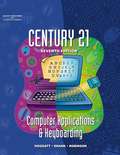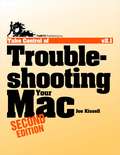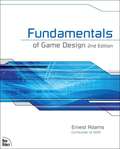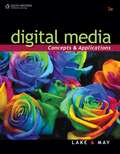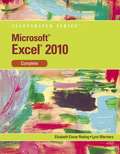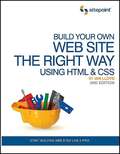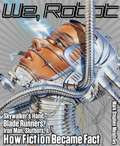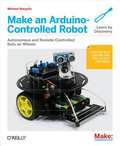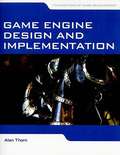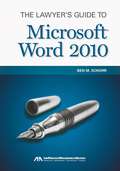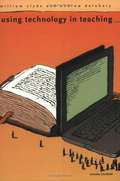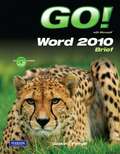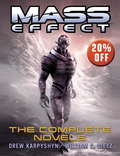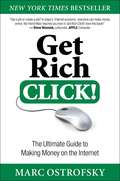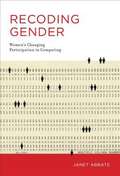- Table View
- List View
Century 21 Computer Applications and Keyboarding (7th Edition)
by Jack P. Hoggatt Jon A. Shank Jerry W. RobinsonThis 7th edition is a revision of Century 21 Keyboarding & Information Processing which reflects the changing keyboarding course. The complete course contains 150 keyboarding and word processing lessons, 54 computer apps lessons, and 15 new key learning lessons (in the Resources section).
Take Control of Troubleshooting Your Mac
by Joe KissellThe 17 basic troubleshooting procedures (along with the reasons why they can help) you'll learn are: Restart your Mac Force-quit an application Start up from another volume Run disk-repair utilities Erase and restore from backup Repair permissions Start up in safe mode Turn off login items Check preference files Reset PMU, SMU, SMC, NVRAM, or PRAM Use Activity Monitor Check free disk space Check log files Clear caches Check your RAM Test for reproducibility Get system information Joe also explains how to solve 15 common problems, including: Your computer won't turn on Your computer keeps turning itself off You experience repeated kernel panics Your Mac is abnormally slow You can't empty the Trash An application grinds to a halt An application crashes The keyboard or mouse doesn't work You lose your Internet connection Printing doesn't work Spotlight searches fail Keychain (seemingly) forgets passwords Apple Mail fails to connect Time Machine misbehaves A volume won't unmount
Fundamentals of Game Design (2nd Edition)
by Ernest AdamsA definitive guide to game theory and design by an industry insider. Comprehensive overview of video game design as it is done in industry. Chapters devoted to each of the major game genres. Exercises of real practical value to help hone your skills. Fundamentals of Game Design, Second Edition teaches the essential theory needed to design entertaining and enjoyable video games. It addresses such key issues as concept development, gameplay design, core mechanics, user interfaces, storytelling, and balancing. The book is aimed at both students in beginning game design courses and anyone that wants to get up-to-speed on the latest game design theory and practice.
Digital Media: Concepts and Applications (3rd Edition)
by Susan E. L. Lake Karen MayDIGITAL MEDIA, CONCEPTS AND APPLICATIONS, 3E prepares students for the workplace by teaching them to use business-standard software applications to complete projects and solve problems. The non-software-specific approach gives students a strong foundation in the concepts and practices of digital multimedia and allows the text to focus on the more creative end of business technology.
Business Computer Information Systems II (Texas Edition)
by Pearson EducationBusiness Computer Information Systems II presents advanced concepts and skills of Microsoft Office XP (Microsoft Word, Microsoft Excel, Microsoft Access, and Microsoft Outlook®). Through a learn-by-doing approach, students are challenged to master Microsoft Office within a business context. Additional features throughout the book also provide insight into how software can be used in other academic areas and in the business world.
Microsoft® Excel® 2010, Illustrated, Complete
by Elizabeth Eisner Reding Lynn WermersLoved by instructors for its visual and flexible way to build computer skills, the Illustrated Series is ideal for teaching MICROSOFT OFFICE EXCEL 2010 to both computer rookies and hotshots. Each two-page spread focuses on a single skill, making information easy to follow and absorb. Large, full-color illustrations represent how the students' screen should look. Concise text introduces the basic principles of the lesson and integrates a case study for further application.
Build Your Own Web Site the Right Way Using HTML & CSS (2nd Edition)
by Ian LloydBuild Your Own Website The Right Way Using HTML & CSS, 2nd Edition teaches web development from scratch, without assuming any previous knowledge of HTML, CSS or web development techniques. This book introduces you to HTML and CSS as you follow along with the author, step-by-step, to build a fully functional web site from the ground up. However, unlike countless other "learn web design" books, this title concentrates on modern, best-practice techniques from the very beginning, which means you'll get it right the first time. The web sites you'll build will: Look good on a PC, Mac or Linux computer Render correctly whether your visitors are using Internet Explorer, Firefox, Opera, or Safari Use web standards so your sites will be fast loading and easy to maintain Be accessible to disabled users who use screen readers to browse the Web By the end of the book, you'll be equipped with enough knowledge to set out on your first projects as a professional web developer, or you can simply use the knowledge you've gained to create attractive, functional, usable and accessible sites for personal use.
Structure, Audience and Soft Power in East Asian Pop Culture
by Chua Beng HuatEast Asian pop culture can be seen as an integrated cultural economy emerging from the rise of Japanese and Korean pop culture as an influential force in the distribution and reception networks of Chinese language pop culture embedded in the ethnic Chinese diaspora. Taking Singapore as a locus of pan-Asian Chineseness, Chua Beng Huat provides detailed analysis of the fragmented reception process of transcultural audiences and the processes of audiences' formation and exercise of consumer power and engagement with national politics. In an era where exercise of military power is increasingly restrained, pop culture has become an important component of soft power diplomacy and transcultural collaborations in a region that is still haunted by colonization and violence. The author notes that the aspirations behind national governments' efforts to use popular culture is limited by the fragmented nature of audiences who respond differently to the same products; by the danger of backlash from other members of the importing country's population that do not consume the popular culture products in question; and by the efforts of the primary consuming country, the People's Republic of China to shape products through co-production strategies and other indirect modes of intervention.
We, Robot: Skywalker's Hand, Blade Runners, Iron Man, Slutbots, and How Fiction Became Fact
by Mark Stephen MeadowsExamining favorite science fiction tales to reveal which robots actually exist today--and what's coming tomorrow--"We, Robot" asks: How close to becoming reality are our favorite science fiction robots? And what might be the real-life consequences of their existence?
Make an Arduino-Controlled Robot
by Michael Margolis<p>Building robots that sense and interact with their environment used to be tricky. Now, Arduino makes it easy. With this book and an Arduino microcontroller and software creation environment, you’ll learn how to build and program a robot that can roam around, sense its environment, and perform a wide variety of tasks.</p>
Game Engine Design and Implementation (Foundations of Game Development)
by Alan ThornAlmost every video game on the market today is powered by a game engine. But, what is a game engine? What does it do? How are they useful to both developers and the game? And how are they made? These, and other important engine related questions, are explored and discussed in this book. In clear and concise language, this book examines through examples and exercises both the design and implementation of a video game engine. Specifically, it focuses on the core components of a game engine, audio and sound systems, file and resource management, graphics and optimization techniques, scripting and physics, and much more. Suitable for students, hobbyists, and independent developers, this no-nonsense book helps fine-tune an understanding of solid engine design and implementation for creating games that sell.
Cloud Computing for Lawyers
by Nicole Black Richard SusskindAs more businesses move their IT systems into the cloud, lawyers need to ask if cloud computing is right for their firm. Cloud Computing for Lawyers features a discussion of cloud computing fundamentals, an overview of legal cloud computing products, and step-by-step instructions for implementing cloud computing in your practice--including practical tips for securing your data.
Google for Lawyers: Essential Search Tips and Productivity Tools
by Carole A. Levitt Mark E. RoschLevitt, an attorney and former law librarian and Rosch, an attorney who runs a website for lawyers doing Internet research, detail how lawyers can use free and low-cost tools available through Google to compete with large firms and their large research and technology budgets. They explain how to use Google Scholar's case law database, Gmail, advertising, and the Google applications: Docs, News, Groups, Images, Blogs, Finance, Books, Chrome, Knol, Maps, Desktop Search, Calendar, Voice, Wave, Analytics, Translate, and other programs for basic and advanced research and office use. They include tips for searching case law and articles; locating information about the opposition, expert witnesses and jurors, and clients; and finding missing witnesses and heirs. Screen shots are included. Annotation ©2010 Book News, Inc. , Portland, OR (booknews. com)
Internet Branding For Lawyers: Building The Client-centered Website
by Jeff LantzCovering methods applicable to firms serving individuals as well as firms serving businesses, this reader-friendly guide shows how to create a brand and a website for a law firm. Lantz, a consultant in brand creation and website development who holds an MBA in finance, advises readers to focus on the customer perspective: how will you help me and how much will it cost. The book begins by explaining the increased importance of branding in today's information age, then explains how to build a brand around the law firm's practices and how to communicate the brand through website content and design. The final section of the book is given over to technical details and decisions related to areas such as content management systems, choosing a website developer, search optimization, domain names, and servers and website hosting. The book includes many bullets and checklists, along with b&w photos, screenshots, and examples of logos. Annotation ©2012 Book News, Inc. , Portland, OR (booknews. com)
The Lawyer's Guide to Microsoft® Outlook 2010
by Ben M. SchorrThe Lawyer's Guide to Microsoft® Outlook 2010 is the only guide written specifically for lawyers to help you be more productive, more efficient and more successful. More than just email, Outlook is also a powerful task, contact, and scheduling manager that will improve your practice.
The Lawyer's Guide to Microsoft® Word 2010
by Ben M. SchorrThis handy reference includes clear explanations, legal-specific descriptions, and time-saving tips for getting the most out of Microsoft Word®--and customizing it for the needs of today's legal professional. Focusing on the tools and features that are essential for lawyers in their everyday practice, The Lawyer's Guide to Microsoft® Word 2010 explains in detail the key components to help make you more effective, more efficient, and more successful.
LinkedIn® In One Hour for Lawyers
by Dennis Kennedy Allison C. ShieldsLawyers work in a world of networks, connections, referrals, and recommendations. For many lawyers, the success of these networks determines the success of their practice. LinkedIn®, the premier social networking tool for business, can help you create, nurture, and expand your professional network and gain clients in the process. LinkedIn® in One Hour for Lawyers provides an introduction to this powerful tool in terms that any attorney can understand
Social Media for Lawyers: The Next Frontier
by Nicole Black Carolyn ElefantAttorneys Elefant and Black provide a variety of ways for lawyers to take advantage of social media in their practice. General topics include: an overview of social media in the legal profession, why it is gaining traction with lawyers, types of social media platforms, choosing and implementing social media tools, networking and relationship building, branding and search engine optimization, getting started, best practices, and ethical and legal issues. Annotation ©2010 Book News, Inc. , Portland, OR (booknews. com)
iPad Apps In One Hour for Lawyers
by Tom MighellFinding the best apps often can be an overwhelming, confusing, and frustrating process. iPad Apps in One Hour for Lawyers provides the "best of the best" apps that are essential for any law practice. In just one hour, you will learn about the apps most worthy of your time and attention. This book will describe how to buy, install, and update iPad apps
Using Technology in Teaching
by William Clyde Andrew DeloheryComputers can help teachers accomplish many of their tasks more efficiently and effectively, but how can a time-strapped teacher determine which pieces of technology are likely to be most helpful? This easy-to-read book offers useful guidance for real-world situations. Organized around specific instructional goals (improving student writing, promoting collaborative learning) and commonly encountered tasks (communicating with students between class, distributing course materials), the book shows teachers at all instructional levels when and how technology can help them meet everyday challenges. Written in an anecdotal, non-technical style, the book and its accompanying CD-ROM cover how to use technology to: communicate with students distribute course materials promote collaborative learning learn through experience clarify course objectives improve student writing develop student research skills use assessment and feedback collect course materials identify plagiarism and more Teachers looking for tools to help them work better and more quickly will welcome this invaluable guide to the technology that will expedite their search.
Digital Logic Design: A Rigorous Approach
by Guy Even Moti MedinaThis textbook, based on the author's fifteen years of teaching, is a complete teaching tool for turning students into logic designers in one semester. Each chapter describes new concepts, giving extensive applications and examples. Assuming no prior knowledge of discrete mathematics, the authors introduce all background in propositional logic, asymptotics, graphs, hardware and electronics. Important features of the presentation are: • All material is presented in full detail. Every designed circuit is formally specified and implemented, the correctness of the implementation is proved, and the cost and delay are analyzed • Algorithmic solutions are offered for logical simulation, computation of propagation delay and minimum clock period • Connections are drawn from the physical analog world to the digital abstraction • The language of graphs is used to describe formulas and circuits • Hundreds of figures, examples and exercises enhance understanding. The extensive website (http://www. eng. tau. ac. il/~guy/Even-Medina/) includes teaching slides, links to Logisim and a DLX assembly simulator.
Go! With Microsoft Word 2010 (Brief Edition)
by Shelley Gaskin Robert L. FerrettFor introductory computer courses on Microsoft Word 2010 or courses in computer concepts with a lab component on Word. Teach the course YOU want in LESS TIME! The primary goal of the GO! Series, aside from teaching computer applications, is ease of implementation. This approach is based on clearly defined projects for students and a one-of-a-kind supplements package for instructors.
Mass Effect: The Complete Novels 4-Book Bundle
by William C. Dietz Drew KarpyshynPicking up where the bestselling videogames left off, the Mass Effect novels take readers into the far reaches of outer space. From the prequel novel, Revelation, to the series capstone, Deception, these original adventures weave together a science fiction epic as they follow Starship Alliance commander David Anderson and his young protégée, scientist Kahlee Sanders, in their battle to save humanity. Packaged together for the first time, this exhilarating eBook bundle includes: REVELATION ASCENSION RETRIBUTION DECEPTION Since discovering a cache of Prothean technology on Mars in 2148, humanity has spread to the stars. Now, on the edge of colonized space, ship commander and Alliance war hero David Anderson investigates the remains of a top secret military research station. Who attacked this post and for what purpose? And where is Kahlee Sanders, the young scientist who mysteriously vanished from the base hours before her colleagues were slaughtered? Sanders is now the prime suspect, but finding her creates more problems than it solves. Partnered with a rogue alien agent he can't trust and pursued by an assassin he can't escape, Anderson battles impossible odds on uncharted worlds to uncover a sinister conspiracy--one he won't live to tell about. Or so the enemy thinks.
Get Rich Click!
by Marc OstrofskyThe Internet is arguably the most powerful business tool in the history of mankind. You can use it to make money, save money, and create new revenue streams quickly and easily, often with no start-up capital. The Internet is changing the way business is conducted and fortunes are made! Get Rich Click! shows you how to jump in and begin making money online immediately. Author Marc Ostrofsky is an entrepreneur and Internet pioneer whose companies make $75 million annually. He outlines the strategies that made him a multimillionaire despite having no technical skills and never creating a single website. His key to success: "Know your strengths, outsource your weaknesses, and know what you don't know." Using real-life examples from people of all ages and walks of life who have made their fortunes online, this engaging guide gives you step-by-step instructions for achieving financial success. You'll learn hundreds of unique ways to make money online with Facebook, Twitter, and other social sites, domain names, Pay Per Click, digitally based products, ways to make money with no money--even how to get a check each month from Google! He teaches: The key to financial success in our Internet-based economy is "Learn More, Earn MoreTM." If you think you've missed the window of opportunity in the digital world, Marc Ostrofsky says otherwise. Everyone has the capacity to learn and profit in the new economy--no matter what their skills, knowledge, or experience. Now is the time to change your ideas about making money, accumulating wealth, and taking control of your financial future. Let Marc Ostrofsky show you the way in Get Rich Click!
Recoding Gender
by Janet AbbateToday, women earn a relatively low percentage of computer science degrees and hold proportionately few technical computing jobs. Meanwhile, the stereotype of the male "computer geek" seems to be everywhere in popular culture. Few people know that women were a significant presence in the early decades of computing in both the United States and Britain. Indeed, programming in postwar years was considered woman's work (perhaps in contrast to the more manly task of building the computers themselves). In Recoding Gender, Janet Abbate explores the untold history of women in computer science and programming from the Second World War to the late twentieth century. Demonstrating how gender has shaped the culture of computing, she offers a valuable historical perspective on today's concerns over women's underrepresentation in the field. Abbate describes the experiences of women who worked with the earliest electronic digital computers: Colossus, the wartime codebreaking computer at Bletchley Park outside London, and the American ENIAC, developed to calculate ballistics. She examines postwar methods for recruiting programmers, and the 1960s redefinition of programming as the more masculine "software engineering." She describes the social and business innovations of two early software entrepreneurs, Elsie Shutt and Stephanie Shirley; and she examines the career paths of women in academic computer science. Abbate's account of the bold and creative strategies of women who loved computing work, excelled at it, and forged successful careers will provide inspiration for those working to change gendered computing culture.
